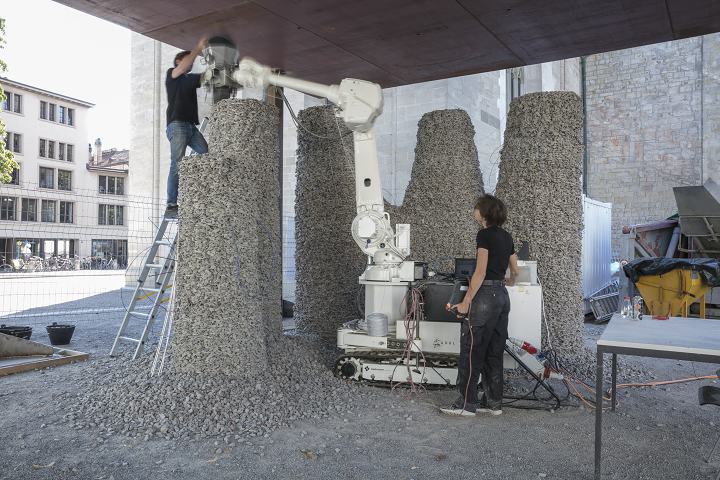
Rock Print Pavilion by Gramazio Kohler Research / ETH Zurich on the church square in front of the Gewerbemuseum Winterthur, construction phase in September 2018
While plastic is used often in 3D printing, stronger materials are required for architecture and construction applications, such as brick, concrete, and cement. But while we’ve seen stone-filled PLA filaments, rocks and stones aren’t often used as raw 3D printing materials…at least not yet.
But three years ago, the Self-Assembly Lab at MIT and Gramazio Kohler Research of ETH Zurich in Switzerland completed an architectural installation called “Rock Print” in Chicago using a method that takes advantage of the jamming principle, where material (synthetic rock in this case) is packed together so tightly that it holds its shape without a container. In this instance, twine helps hold the layers together.
Earlier today, ETH Zurich showcased its innovative, ongoing “Design and Robotic Fabrication of Jammed Architectural Structures” research project with an important unveiling. On Kirchplatz Square in front of the Gewerbemuseum Winterthur in Switzerland, a mobile construction robot had built an outdoor “Rock Print Pavilion” out of 120 km of string and over 30 metric tons of loose stones.
These structures are reusable, and, due to their high geometrical flexibility, can be reconfigured with little wasted material. The jamming principle is put to work here, but with a big difference: the team from ETH Zurich’s Gramazio Kohler Research are using it to target the macro-scale, rather than the usual nano- and meso-scale applications. When combined with automated fabrication technology, like 3D printing, and computational design and simulation, this makes the project perfect for architectural construction.
The Rock Print Pavilion project is meant to explore the many possibilities that are available through digital and robotic manufacturing. The robotic 3D printing process requires no tools, and recycling is built right in, as it’s easy to dismantle the components and reuse the loose aggregate material and twine, which is tied around the heap of tightly packed stones by the robot itself.
The “In situ Fabricator” 3D printing construction robot spent the last month constructing a total of 11 pillars, each one reaching 11 meters high, out of the loose stones and string. Jamming makes the stones interlock together, and once the string is arranged between each of the gravel layers by the robotic calculations, the resulting structure is durable and stable enough to support a steel roof that weighs eight metric tons…pretty impressive, to say the least.
The Rock Pavilion Project by the Gramazio Kohler Research team is definitely a good example of how new and emerging digital constructions processes can truly be transformative.
- Saturday, October 6, 2018, 11 am
- Saturday, October 14, 2018, 11 am
- Saturday, October 20, 2018, 11 am
- Sunday, November 4, 2018, 2 pm
Discuss this story and other 3D printing topics at 3DPrintBoard.com or share your thoughts in the Facebook comments below.
[Images provided by ETH Zurich]